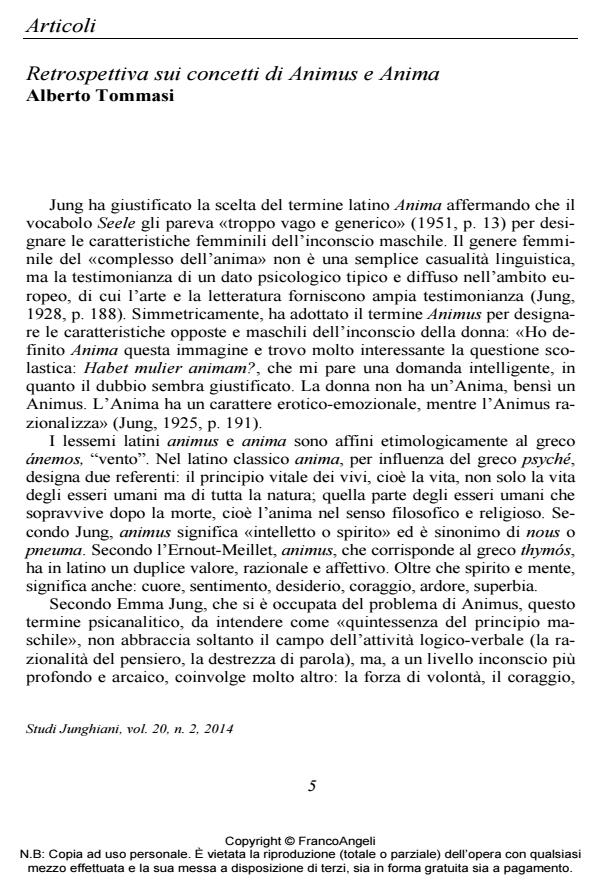Retrospective on animus and anima
Journal title STUDI JUNGHIANI
Author/s
Publishing Year 2015 Issue 2014/40 Language Italian
Pages 17 P. 5-21 File size 74 KB
DOI 10.3280/JUN2014-040001
DOI is like a bar code for intellectual property: to have more infomation
click here
Below, you can see the article first page
If you want to buy this article in PDF format, you can do it, following the instructions to buy download credits

FrancoAngeli is member of Publishers International Linking Association, Inc (PILA), a not-for-profit association which run the CrossRef service enabling links to and from online scholarly content.
This work first outlines the basic theory of C.G. Jung on animus and anima. Furthermoreit suggests considering the instance of persona, in which field the gender models of collectiveculture assume normative character. The author then particularly analyses the problemof animus as a mediator between consciousness and the unconscious by comparing Jungiantheory with E. Jung, J. Hillman and E. Neumann. He creates a scheme showing that the consciousnessof woman is currently relying on a double identity, both feminine and masculine,with the coexistence of animus and anima in the unconscious. A crucial point of the basictheory is the complementarity of soul-image and persona, which implies that a historicalvariation of the second instance causes a modification also in the first one. The decrease ingender differences on a conscious level could have modified the compensatory drive of theunconscious. In Jung’s age, this had a decisive contrasexual character while nowadays manyanalytical psychologists recognize the coexistence of archetypes of the feminine and masculinein the collective unconscious of both sex individuals.
Keywords: C.G. Jung, J. Hillman, animus, anima, persona, gender models
- Bettini M. (2000). Mos, mores e mos maiorum. In: Le orecchie di Hermes: studi di antropologia e letterature classiche. Torino: Einaudi, pp. 241-292.
- Ernout A., Meillet A. (1967). Dictionnaire Étymologique de la Langue Latine: Histoire des Mots. IV ed. Paris: Klincksieck.
- Franz M-L., von (1972). C.G. Jung: sein Mythos in unserer Zeit. Frauenfeld: Huber (trad. it. Il mito di Jung. Torino: Bollati Boringhieri, 1978).
- Hillman J. (1974). Anima. Spring 1973 e 1974 (trad. it. Anima: anatomia di una nozione personificata. Milano: Adelphi, 2008).
- Hillman J. (1975). Re-Visioning Psychology. New York: Harper & Row (trad. it. Re-visione della psicologia. Milano: Adelphi, 2008).
- Jung C.G. (1916). Die transzendente Funktion (trad. it. La funzione trascendente. In: Opere, vol. 8. Torino: Boringhieri, 1976).
- Jung C.G. (1921). Psychologische Typen (trad. it. Tipi psicologici. In: Opere, vol. 6. Torino: Bollati Boringhieri, 1969).
- Jung C.G. (1925). Die Ehe als psychologische Beziehung (trad. it. Il matrimonio come relazione psicologica. In: Opere, vol. 17. Torino: Bollati Boringhieri, 1991).
- Jung C.G. (1928). Die Beziehungen zwischen dem Ich und dem Unbewussten (trad. it. L’Io e l’inconscio. In: Opere, vol. 7. Torino: Bollati Boringhieri, 1983).
- Jung C.G. (1951). Aion: Beiträge zur Symbolik des Selbst (trad. it. Aion: ricerche sul simbolismo del Sé. In: Opere, vol. 9, 2. Torino: Bollati Boringhieri, 1982). Jung E. (1934). Ein Beitrag zum Problem des Animus. In: C.G. Jung, Wirklichkeit der Seele.
- Zürich: Rascher (trad. it. Il problema dell’Animus. In: E. Jung, Animus e Anima. Torino: Bollati Boringhieri, 1992, pp. 31-70).
- Kast V. (1984). Paare: Beziehungsphantasien oder wie Götter sich in Menschen spiegeln. Stuttgart: Kreuz (trad. it. La coppia: realtà e immaginario nelle relazioni d’amore. Milano: red, 1991).
- Kast V. (1993). Animus and Anima: Spiritual Growth and Separation from the Parental Complexes. Harvest, 39: 5-15.
- Kast V. (1994). Vater-Töchter Mutter-Söhne: Wege zur eigenen Identität aus Vater- und Mutterkomplexen. II ed. Freiburg i. B.: Kreuz, 2005.
- Moore R., Gillette D. (1990). King Warrior Magician Lover: Rediscovering the Archetypes of the Mature Masculine. New York: Harper Collins.
- Neumann E. (1953). Zur Psychologie des Weiblichen. Zürich: Rascher (trad. it. La psicologia del femminile. Roma: Astrolabio, 1975).
- Pieri P. F. (1998). Dizionario junghiano, 2 ed. ridotta. Torino: Bollati Boringhieri, 2005.
- Riedel I. (1998). Neue Konzepte des Weiblichen in der Psychologie C.G. Jungs. Wege zum Menschen, 50: 270-284.
, Retrospettiva sui concetti di Animus e Anima in "STUDI JUNGHIANI" 40/2014, pp 5-21, DOI: 10.3280/JUN2014-040001